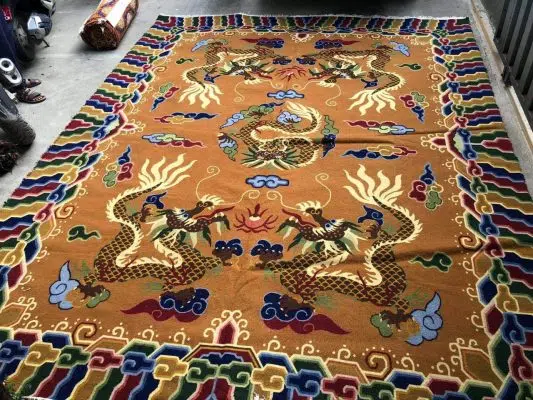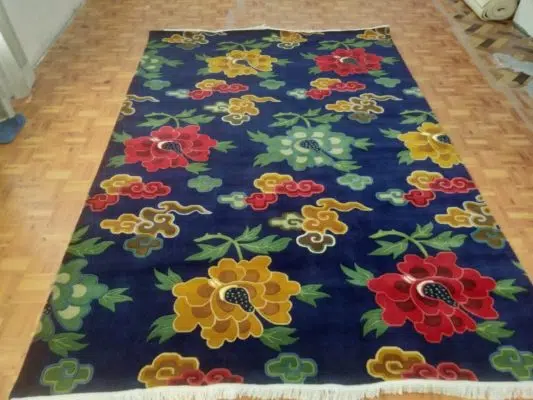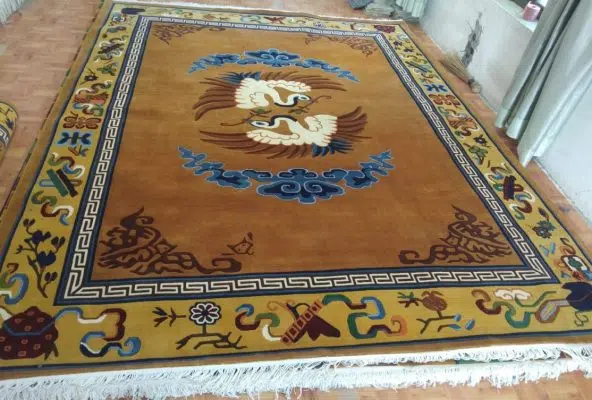Blog
Handwoven Tibetan Rugs and Carpets
![]()
Table of Contents
Handwoven Tibetan Rugs and Carpets: A Comprehensive Guide
Handwoven Tibetan rugs and carpets are not just floor coverings; they are works of art that embody the rich cultural heritage and skilled craftsmanship of Tibetan artisans. This guide delves into the history, craftsmanship, materials, designs, care, and the contemporary appeal of these exquisite rugs and carpets.
The History and Cultural Significance of Tibetan Rugs and Carpets
Tibetan rugs and carpets have a history that stretches back centuries, deeply intertwined with the cultural and spiritual life of the Tibetan people. Traditionally, these rugs were made for practical purposes, such as seating, sleeping, and for use in monasteries. However, their intricate designs and craftsmanship have also made them significant as symbols of wealth and status.
Tibetan carpets often feature motifs and patterns that hold religious and cultural significance. Symbols such as the lotus, dragons, and the endless knot are common, each carrying specific meanings related to Buddhist philosophy. The craft of rug-making in Tibet has been passed down through generations, with each artisan adding their unique touch to the time-honored designs.
The Art of Handweaving: Techniques and Craftsmanship
The process of creating a handwoven Tibetan rug is labor-intensive and requires a high level of skill. The primary technique used is the Tibetan knot, which is distinct from other knotting methods used in rug-making around the world. This technique involves looping the yarn around a rod, which is then cut and tied, creating a pile that is both dense and resilient.
Artisans use wooden looms to weave the rugs, a process that can take several months depending on the size and complexity of the design. The weavers often work from memory or follow intricate patterns drawn on graph paper, ensuring each knot is placed precisely. The result is a rug that is not only beautiful but also durable, capable of withstanding years of use.
Materials Used in Handwoven Tibetan Rugs and Carpets
One of the defining features of Tibetan rugs is the quality of the materials used. The primary material is wool from sheep that graze in the high altitudes of the Tibetan plateau. This wool is known for its softness, strength, and natural luster. It is also highly resilient, making it ideal for rug-making.
In addition to wool, some Tibetan rugs incorporate silk to add a touch of luxury and sheen. The use of natural dyes derived from plants, minerals, and insects is also a hallmark of Tibetan rugs. These dyes produce rich, vibrant colors that are both beautiful and environmentally friendly.

Traditional and Contemporary Designs
Tibetan rugs and carpets are renowned for their distinctive designs, which range from traditional motifs to contemporary patterns. Traditional designs often feature geometric shapes, floral patterns, and Buddhist symbols. These designs are not only aesthetically pleasing but also carry deep cultural and spiritual meanings.
In recent years, contemporary designers have started to experiment with Tibetan rug-making techniques, creating modern patterns and color schemes that appeal to a global audience. These contemporary designs retain the quality and craftsmanship of traditional Tibetan rugs while offering fresh and innovative aesthetics.
The Benefits of Handwoven Tibetan Rugs and Carpets
Handwoven Tibetan rugs offer several benefits beyond their visual appeal. One of the primary advantages is their durability. The high-quality wool and tight knotting technique ensure that these rugs can withstand heavy foot traffic and last for decades with proper care.
Another benefit is their natural insulation properties. Tibetan wool is excellent at retaining heat, making these rugs ideal for colder climates. They also have sound-absorbing qualities, which can help reduce noise in a room and create a more peaceful environment.
How to Care for Your Handwoven Tibetan Rug
Proper care is essential to maintain the beauty and longevity of a handwoven Tibetan rug. Regular vacuuming is important to remove dirt and debris that can damage the fibers. It is also recommended to rotate the rug periodically to ensure even wear.
For spills and stains, it is best to address them immediately. Blot the area with a clean, dry cloth and avoid rubbing, which can cause the stain to set deeper into the fibers. For more thorough cleaning, professional rug cleaning services are recommended to preserve the integrity of the rug.
Where to Buy Handwoven Tibetan Rugs and Carpets
Handwoven Tibetan rugs and carpets can be purchased from a variety of sources. Specialty rug stores, both physical and online, often carry a selection of these rugs. When buying a Tibetan rug, it is important to ensure that you are purchasing from a reputable dealer who can provide information about the rug’s origin and craftsmanship.
Many artisans and cooperatives in Tibet and Nepal sell their rugs directly to consumers, offering an opportunity to support the local economy and ensure that the artisans receive fair compensation for their work. These rugs are often sold through online marketplaces or during exhibitions and trade shows.
The Future of Handwoven Tibetan Rugs and Carpets
The future of handwoven Tibetan rugs and carpets looks promising as more people around the world appreciate the beauty and craftsmanship of these unique textiles. Efforts to preserve traditional techniques and promote fair trade practices are helping to sustain the industry and support the artisans who create these works of art.
Additionally, the integration of contemporary designs with traditional techniques is attracting a new generation of consumers who value both heritage and modern aesthetics. As awareness of sustainable and ethical production practices grows, handwoven Tibetan rugs are likely to continue gaining popularity as a choice for eco-conscious consumers.

Handwoven Tibetan Rugs and Carpets: The Intersection of Art and Utility
Handwoven Tibetan rugs and carpets are a remarkable blend of art and utility, making them treasured possessions for many homeowners and collectors. Their unique patterns, rich history, and the dedication required to create each piece distinguish them in the world of textiles. This section will delve deeper into the intricate world of Tibetan rug-making, covering aspects like the socio-economic impact of the industry, the process of natural dyeing, the role of rugs in Tibetan households, and the evolution of the market.
Socio-Economic Impact of the Tibetan Rug Industry
The handwoven Tibetan rug industry plays a crucial role in the socio-economic fabric of Tibet and surrounding regions, such as Nepal and Bhutan. For many families, rug-making is a primary source of income, supporting livelihoods in areas where opportunities are limited. The skills required for this craft are often passed down through generations, ensuring that the tradition continues and provides steady employment.
Fair trade organizations and cooperatives have been instrumental in ensuring that artisans receive fair compensation for their work. These entities help artisans access global markets, which increases their income potential and encourages the preservation of traditional techniques. By purchasing handwoven Tibetan rugs from these organizations, consumers can support ethical practices and contribute to the well-being of the artisans and their communities.
The Natural Dyeing Process
One of the distinguishing features of handwoven Tibetan rugs is the use of natural dyes. The process of creating these dyes is an art in itself, involving the extraction of colors from various natural sources. Plants, minerals, and insects provide a rich palette of colors that are both vibrant and environmentally friendly.
For instance, madder root yields reds and pinks, indigo plants provide blues, and walnut husks create rich browns. The dyeing process requires careful preparation and timing to achieve the desired hues. The wool is often dyed in small batches to ensure consistency and depth of color. The use of natural dyes not only enhances the beauty of the rugs but also ensures that they age gracefully, with colors that remain vibrant over time.
The Role of Rugs in Tibetan Households
In traditional Tibetan households, rugs and carpets are not merely decorative items; they serve several practical purposes. Rugs are often used as seating mats, bed coverings, and even as saddle blankets for horses and yaks. Their versatility and durability make them essential household items.
Tibetan monasteries also use rugs extensively. Monks use them during prayer and meditation, and the intricate designs often incorporate religious symbols and motifs. These rugs create a serene and sacred atmosphere conducive to spiritual practices.
Also visit:-
Evolution of the Market for Tibetan Rugs
The market for Tibetan rugs has evolved significantly over the years. Once primarily traded within local and regional markets, these rugs have now gained international acclaim. The growing appreciation for handcrafted goods and sustainable practices has increased the demand for authentic Tibetan rugs.
Art collectors and interior designers around the world value Tibetan rugs for their unique beauty and cultural significance. As a result, the market has seen an increase in bespoke orders, where clients can request specific designs and sizes tailored to their needs. This customization trend has helped artisans experiment with new patterns and color schemes, blending traditional elements with contemporary aesthetics.
Challenges Facing the Industry
Despite their popularity, the handwoven Tibetan rug industry faces several challenges. One significant issue is the availability of raw materials. The high-altitude wool used in these rugs is of exceptional quality but can be difficult to source consistently due to environmental changes and geopolitical factors.
Another challenge is the preservation of traditional skills. Younger generations are often drawn to urban areas and different career opportunities, leading to a decline in the number of skilled artisans. Efforts by non-profits and cultural organizations to provide training and support for young weavers are crucial to ensuring the survival of this ancient craft.
Innovations in Design and Technique
While the handwoven Tibetan rug industry is steeped in tradition, it is also a space for innovation. Contemporary designers are collaborating with Tibetan artisans to create new patterns and techniques that appeal to modern tastes. These collaborations often result in stunning pieces that combine the best of traditional craftsmanship with cutting-edge design.
One such innovation is the incorporation of silk and other luxurious fibers into the wool base, creating rugs with an added sheen and softness. Additionally, new dyeing techniques are being explored to expand the color palette and introduce new hues that complement contemporary interiors.
The Environmental Benefits of Handwoven Tibetan Rugs
Handwoven Tibetan rugs are not only beautiful but also environmentally friendly. The use of natural dyes and sustainable wool production practices minimizes the environmental impact. Unlike synthetic fibers and dyes, natural materials do not release harmful chemicals into the environment, making these rugs a greener choice for eco-conscious consumers.
Moreover, the durability of these rugs means they do not need to be replaced frequently, reducing waste. When they do eventually wear out, the natural fibers are biodegradable, ensuring that they do not contribute to landfill problems.
Investing in Handwoven Tibetan Rugs
Purchasing a handwoven Tibetan rug is an investment in both art and quality. These rugs often appreciate in value over time, especially those with unique designs or those made by renowned artisans. For collectors, owning a piece of this cultural heritage can be a source of pride and a tangible connection to Tibetan traditions.
For homeowners, these rugs offer unmatched warmth and beauty. They can transform a space, adding depth and character that machine-made rugs cannot replicate. By investing in a handwoven Tibetan rug, you not only enhance your home’s aesthetic but also support a centuries-old craft and the artisans who keep it alive.
Also visit:-
Conclusion
Handwoven Tibetan rugs and carpets are more than just decorative items; they are a testament to the rich cultural heritage and skilled craftsmanship of Tibetan artisans. From their historical significance and traditional techniques to their modern adaptations and sustainable benefits, these rugs embody a timeless appeal that transcends generations. Whether used as a centerpiece in a living room or as a cozy addition to a bedroom, a handwoven Tibetan rug brings beauty, warmth, and a touch of history into any home.
Handwoven Tibetan rugs and carpets represent a unique intersection of culture, craftsmanship, and sustainability. Their rich history, intricate designs, and the dedication required to create each piece make them more than just floor coverings—they are works of art that tell a story. As the market for these rugs continues to evolve, the future looks bright for both the artisans who create them and the consumers who appreciate their beauty and heritage. Whether you are a collector, a decorator, or simply someone who appreciates fine craftsmanship, a handwoven Tibetan rug is a timeless addition to any home.

FAQs for Handwoven Tibetan Rugs and Carpets
- What are handwoven Tibetan rugs and carpets?
– Handwoven Tibetan rugs and carpets are crafted by skilled artisans using traditional weaving techniques. They are known for their intricate designs and high-quality wool.
- How are handwoven Tibetan rugs made?
– These rugs are created using a loom where artisans meticulously weave wool into detailed patterns, knot by knot, following traditional Tibetan methods.
- What materials are used in handwoven Tibetan rugs and carpets?
– They are typically made from high-altitude Tibetan or Himalayan sheep wool. Some may also incorporate silk or other natural fibers and are often dyed using natural dyes.
- What distinguishes a handwoven rug from a machine-made rug?
– Handwoven rugs feature unique, intricate designs and superior craftsmanship, with each knot tied individually. Machine-made rugs lack the personal touch and detail of handwoven items.
- What are the common designs in handwoven Tibetan rugs?
– Designs often include Buddhist symbols, geometric patterns, and motifs inspired by nature. Each design carries cultural and spiritual significance.
- How long does it take to create a handwoven Tibetan rug?
– The time varies based on size and complexity. A small rug might take a few weeks, while a larger, more intricate rug can take several months.
- Are handwoven Tibetan rugs durable?
– Yes, they are highly durable due to the quality of the wool and the meticulous weaving technique. With proper care, they can last for decades.
- How should I clean my handwoven Tibetan rug?
– Regular vacuuming, spot cleaning, and professional cleaning every 1-2 years are recommended. Avoid excessive moisture and direct sunlight to preserve the rug.
- Can I customize a handwoven Tibetan rug?
– Yes, many artisans offer customization options. You can choose specific colors, patterns, and sizes to match your preferences.
- Why are natural dyes used in handwoven Tibetan rugs?
– Natural dyes provide rich, lasting colors and are environmentally friendly. They give each rug a unique, organic appearance and are safer for artisans and consumers.
- How can I verify if a rug is truly handwoven?
– Look for slight irregularities in the pattern and knots, indicating handweaving. The back should show individual knots rather than a uniform backing typical of machine-made rugs.
- Are handwoven Tibetan rugs eco-friendly?
– Yes, they are eco-friendly due to the use of natural materials and dyes. Traditional grazing practices for wool production are generally sustainable, and handweaving minimizes energy use.
- Do handwoven Tibetan rugs appreciate in value?
– High-quality handwoven Tibetan rugs can appreciate in value over time, especially if well-maintained and featuring unique designs. Antique and rare rugs are particularly valuable to collectors.
- What sizes are available for handwoven Tibetan rugs?
– They come in various sizes, from small mats to large area rugs. Custom sizes can also be ordered to fit specific spaces.
- Can handwoven Tibetan rugs be used with underfloor heating?
– Yes, but ensure that the wool and dyes are compatible with underfloor heating systems. Avoid extreme temperatures to prevent damage.
- How do handwoven Tibetan rugs compare to Persian rugs?
– While both are handwoven and made from high-quality wool, Tibetan rugs often feature Buddhist motifs, while Persian rugs typically have floral and geometric patterns. The cultural influences and techniques also differ.
- Are handwoven Tibetan rugs hypoallergenic?
– Wool used in these rugs naturally resists dust mites and bacteria, making them a good choice for allergy sufferers. Regular cleaning is essential to minimize allergens like dust and pet dander.
- What is knot density in a handwoven Tibetan rug?
– Knot density refers to the number of knots per square inch (KPSI). Higher knot density generally indicates a more detailed and durable rug. Tibetan rugs typically have a lower KPSI compared to Persian rugs but are still highly durable and beautiful.
- Can handwoven Tibetan rugs be used in high-traffic areas?
– Yes, their durability makes them suitable for high-traffic areas like living rooms, hallways, and entryways. Regular maintenance will keep them looking their best.
- How should I store a handwoven Tibetan rug?
– Clean the rug thoroughly before storing. Roll it with the pile facing inward and wrap it in a breathable fabric or cotton sheet. Store it in a cool, dry place away from direct sunlight and moisture.
- Are handwoven Tibetan rugs flame-resistant?
– Wool is naturally flame-resistant, providing an added safety benefit. However, keep the rug away from direct heat sources and open flames.
- Can handwoven Tibetan rugs be layered over other carpets?
– Yes, layering a handwoven Tibetan rug over another carpet can add depth, texture, and interest to your decor. Use a rug pad to prevent slipping and ensure it lies flat.
- What shapes are available for handwoven Tibetan rugs?
– Common shapes include rectangular, square, round, and runner styles. Custom shapes can also be created to fit unique spaces or design preferences.
- How can I protect my handwoven Tibetan rug from moth damage?
– Regular cleaning, vacuuming, and using moth repellents or cedar products can help protect against moth damage. Ensure the storage area is clean and dry.
- Why are handwoven Tibetan rugs considered works of art?
– Each rug is a unique creation, reflecting the artisan’s skill, cultural heritage, and artistic expression. The intricate designs, quality materials, and traditional techniques contribute to their status as functional works of art.


